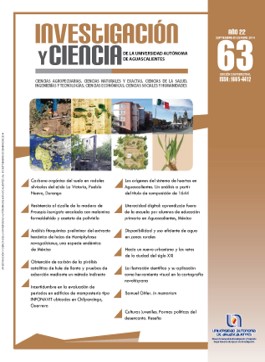Resistencia al cizalle de la madera de Prosopis laevigata encolada con melamina formaldehído y acetato de polivinilo
DOI:
https://doi.org/10.33064/iycuaa2014633606Palabras clave:
adhesivos, desgarre de fibra, encolado, mezquite, tracción, uso exteriorResumen
La madera de Prosopis laevigata (Willd.) M.C. Johnst es ampliamente utilizada en México. Los muebles unidos con clavos o tornillos pueden presentar rajaduras que reducen el valor estético y la resistencia mecánica. En el presente estudio se midió la resistencia al cizallamiento por tracción (MPa) y el porcentaje de ruptura (%) de las fibras de uniones de madera para determinar si el adhesivo
melamina-formaldehído (MF) es más resistente que el acetato de polivinilo (PVAc) en las condiciones de atmósfera normalizada (A1
), húmeda (A2 ) y seca (A3), según la norma UNE-EN 301. La resistencia al cizallamiento presentó diferencias estadísticas altamente significativas (p<0.0001) entre adhesivos y condiciones de deterioro. La madera encolada con MF presentó mayor resistencia al cizallamiento que el PVAc, excepto en la condición A2 . El desgarramiento de fibras varió de 0% a 66%.
Descargas
Citas
• ALAMSYAH, E. et al. Bondability of Tropical Fast-growing Tree Species I: Indonesian Wood Species. Journal of Wood Science, 53(1): 41-45, 2007.
• ALDEN, H. Hardwoods of North America. Gen. Tech. Rep. FPLGTR-83. Madison, WI: U.S. Department of Agriculture, Forest Service, Forest Products Laboratory. 136 pp., 1995.
• CARRILLO, A. et al. Wood Anatomical Characteristics and Chemical Composition of Prosopis laevigata Grown in the Northeast of Mexico. IAWA Journal, 29(1): 25-32, 2008.
• FOLLRICH, J. et al. Bond Strength of End-grain Joints and its Dependence on Surface Roughness and Adhesive Spread. Journal of Wood Science, 56(5): 429-434, 2010.
• FRIHART, C. R. y HUNT, C. G. Adhesives with Wood Materials Bond Formation and Performance. Chapter 10. En Wood Handbook-Wood as an Engineering Material Gen. Tech. Rep. FPL-GTR-190 (pp. 10-1-10-24). Madison, WI: USDA, Forest Serv., Forest Products Laboratory, 2010.
• JUÁREZ-MUÑOZ, J. et al. Inter- and Intra-genetic Variation of Four Wild Populations of Prosopis Using RAPD-PCR Fingerprints. Biodiversity and Conservation, 11: 921-930, 2002.
• KURT, R. et al. Hydroxymethylated Resorcinol (HMR) Priming Agent for Improved Bondability of Wax-treated Wood. Holz als Roh-und Werkstoff, 66(5): 335-338, 2008.
• KURT, R. et al. The Introduction of Engineered Wood Products (EWPs) for the Earthquake Resistant Building Construction in Turkey. Fifth National Conference on Earthquake Engineering. Istanbul, Turkey. 012, 26-30 May. 2003.
• MCKEEVER, D. B. Engineered Wood Products: a Response to the Changing Timber Resource. Pacific Rim Wood Market Report, 5(15), 1997.
• MEZA-SÁNCHEZ, R. y OSUNA-LEAL, E. Estudio dasométrico de mezquite en la zona de las pocitas, B.C.S. Vol. 3. México: Instituto Nacional de Investigaciones Forestales, Agrícolas y Pecuarias, 52, 2003.
• SONG, J. y LIM, J. Bonding Strength in Structural Adhesive Bonded Joint. Metals and Materials International, 7(5): 469-470, 2001.
• TOUT, R. A Review for Adhesives for Furniture. International Journal of Adhesion and Adhesives, 20(4): 269-272, 2000.
• UNE-EN-301, Adhesivos fenólicos y aminoplásticos para estructuras de madera bajo carga. Clasificación y requisitos de comportamiento. 2007.
• UNE-EN-302-1, Adhesivos para madera de uso estructural. Parte 1: Determinación de la resistencia de la unión al cizallamiento por tracción longitudinal. 2005.
• VICK, C. Adhesive Bonding of Wood Materials. En Wood Handbook: Wood as an Engineering Material. General Technical Report (pp. 1-24). Forest Service, 1999.
• ZHAO, L. F. et al. State of Research and Trends in Development of Wood Adhesives. Forestry Studies in China, 13(4): 321-324, 2011.
Descargas
Publicado
Cómo citar
Licencia
Derechos de autor 2014 Artemio Carrillo Parra, Rahim Foroughbakhch, Sadoth Sandoval Torres, Verónica Bustamante García, Christian Wehenkel, Fortunato Garza Ocañas

Esta obra está bajo una licencia internacional Creative Commons Atribución-NoComercial-CompartirIgual 4.0.
Las obras publicadas en versión electrónica de la revista están bajo la licencia Creative Commons Atribución-NoComercial-CompartirIgual 4.0 Internacional (CC BY-NC-SA 4.0)









